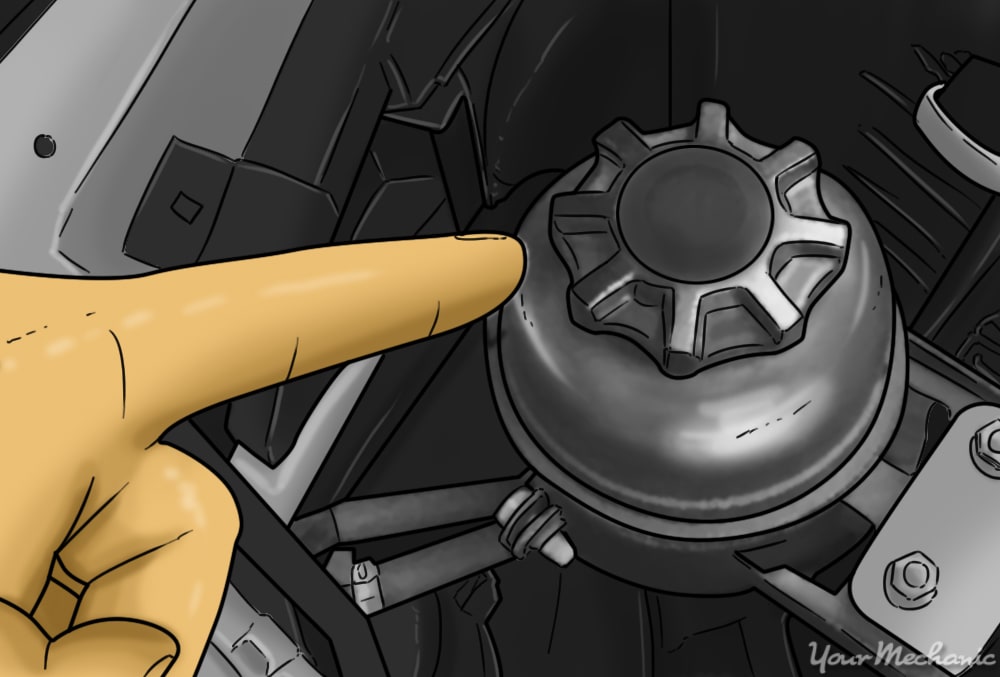

The power steering system is standard on many modern vehicles. This system allows the driver to pilot the vehicle and turn the steering wheel with little to no effort. The power steering fluid is the hydraulic oil used in high pressure hydraulic power steering systems and the type of fluid used can differ between vehicle manufacturers. The proper type and level of oil are essential to the operation of these types of systems and you may start to experience problems if the level becomes low or the wrong fluid is used. Too low a level of fluid may cause serious damage to the working components and repairs can be costly.
Typical symptoms of a low power steering fluid level are:
- Groaning noise
- Groaning noise when turning
Warning: Although brake fluid is another type of hydraulic oil, it is never to be confused with power steering fluid. Pouring either fluid into the wrong reservoir can cause major damage and open up an unsafe driving situation. The vehicle owner's manual will often include information regarding the type of fluids to use for each of the vehicles systems. None of these fluids are designed to mix.
Many manufacturers are switching to an electronic power steering system to make their vehicles more economical. Electronic power steering systems do not require a fluid pump driven by engine rotation to operate which increases fuel economy when compared to the same engine running a hydraulic power steering system. You can find electronic power steering systems on hybrid-vehicles and many compact cars.
- Note: Consult your vehicle's owner's manual first before performing checks on any fluids as the owners manual will generally include information on performing these checks, how, and where to add fluids. If you do find the fluid level is low, the owners manual will also specify which type of fluid should be used.
Method 1 of 1: Checking the power steering fluid level
- Tip: The power steering symbol can typically be found on the power steering reservoir cap.
Materials Needed
- Bottle of specified power steering fluid
- Funnel
- Gloves
- Safety glasses/goggles
- Towel to clean up any spills
- Vehicle owner's manual
- White cloth or paper towel
Step 1: Check the owner's manual for service information. Check your owner's manual for information on your vehicle's power steering system. Power steering reservoir location, fluid level specification and fluid type can be found in the owner's manual.
- Tip: The owners manual will generally tell you where the reservoir is located and which type of fluid to use in the system. This publication will also show you how to read the fluid level markings. Some vehicle fluids are checked while the engine is running.
Step 2: Locate the power steering reservoir. Observe the area around the cap. If the reservoir is wet, the fluid level may have been too high or the cap may have a weak seal.
- Note: Few vehicles are equipped with a vented power steering reservoir cap.
Step 3: Check the fluid level and condition. If you are dealing with a transparent reservoir with level markings, the measurement can generally be found on the side of the reservoir. Other vehicles are equipped with a level indicator affixed to the reservoir cap.
Note: Some vehicles have hot and cold level markings. Power steering fluid expands some when it becomes hot so the fluid level will change. If the vehicle has not been driven for at least 8 hours, use the cold reading. Otherwise, use the hot level reading. If the fluid level is at the add mark or lower, there may be a leak.
Tip: You can use a device like a long pick or the fluid level dipstick to drip the fluid on a white napkin or towel. Compare the color of the old fluid and new. Dark brown or black fluid should be flushed to prevent premature malfunctions.
Some vehicles use ATF (automatic transmission fluid) in the power steering system. You should use whichever fluid is specified in the owner's manual.
Step 4: Top off the power steering fluid if level is low. Using your funnel, slowly pour the fluid into the reservoir. Pour a little fluid at a time and constantly check the level to be sure you don’t overfill the reservoir. If your vehicle uses a fluid level indicator dipstick, it may be necessary to remove the funnel and insert the dipstick between pours to accurately check the fluid level. A low fluid level often indicates a leak in the system and it would be best consult a service professional, like the ones at YourMechanic, for assistance.
The power steering fluid should be checked along with the other vehicle fluids at least at every oil change interval. Periodic inspection of the vehicle's fluids can alert the user of any concerns before they become more expensive repairs. Consult your vehicle owner's manual for the recommended service intervals. If your power steering fluid seems very dirty, consider hiring one of our mobile experts at YourMechanic to handle the dirty work for you.



